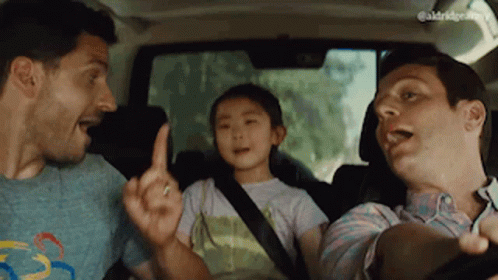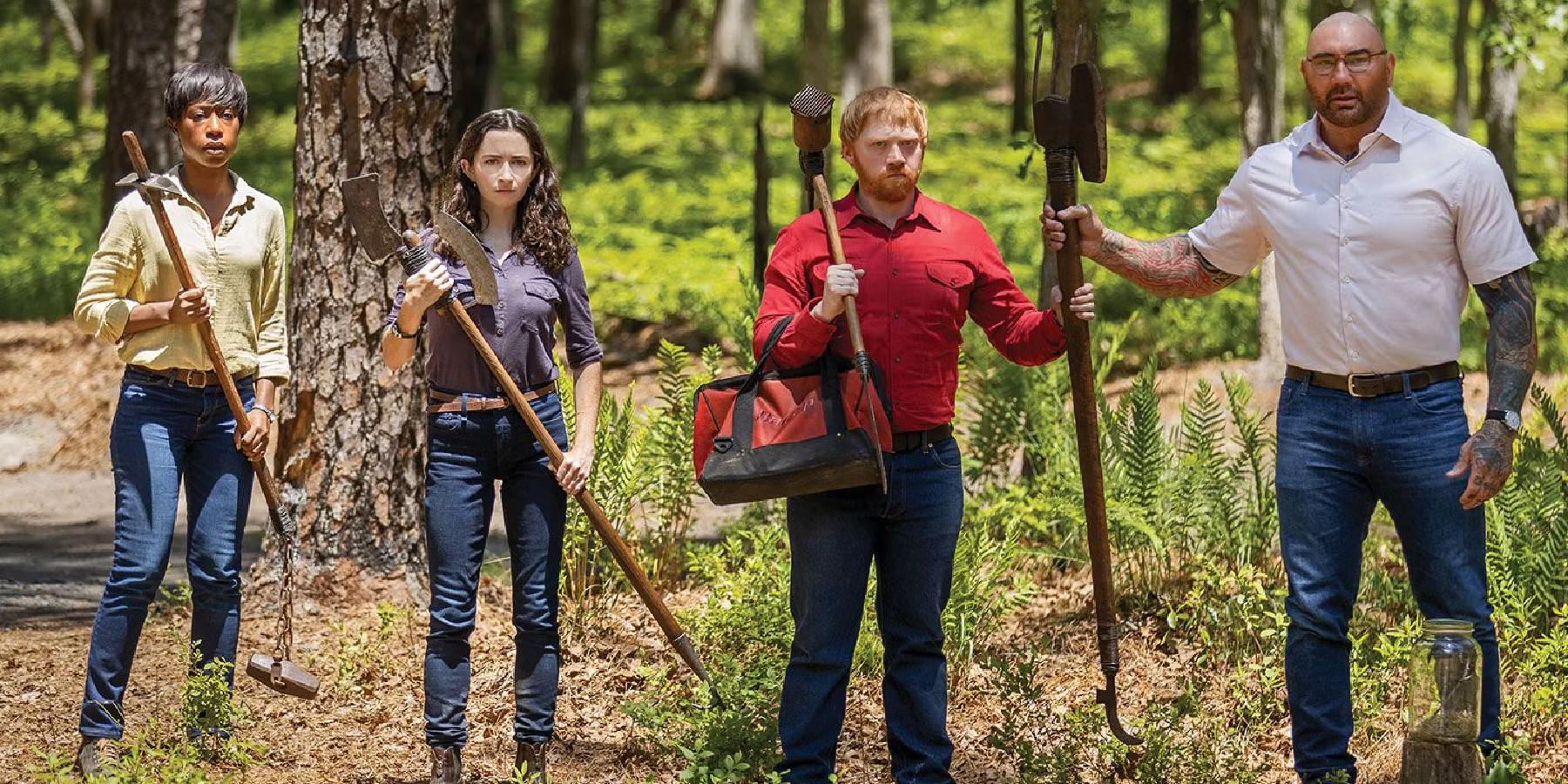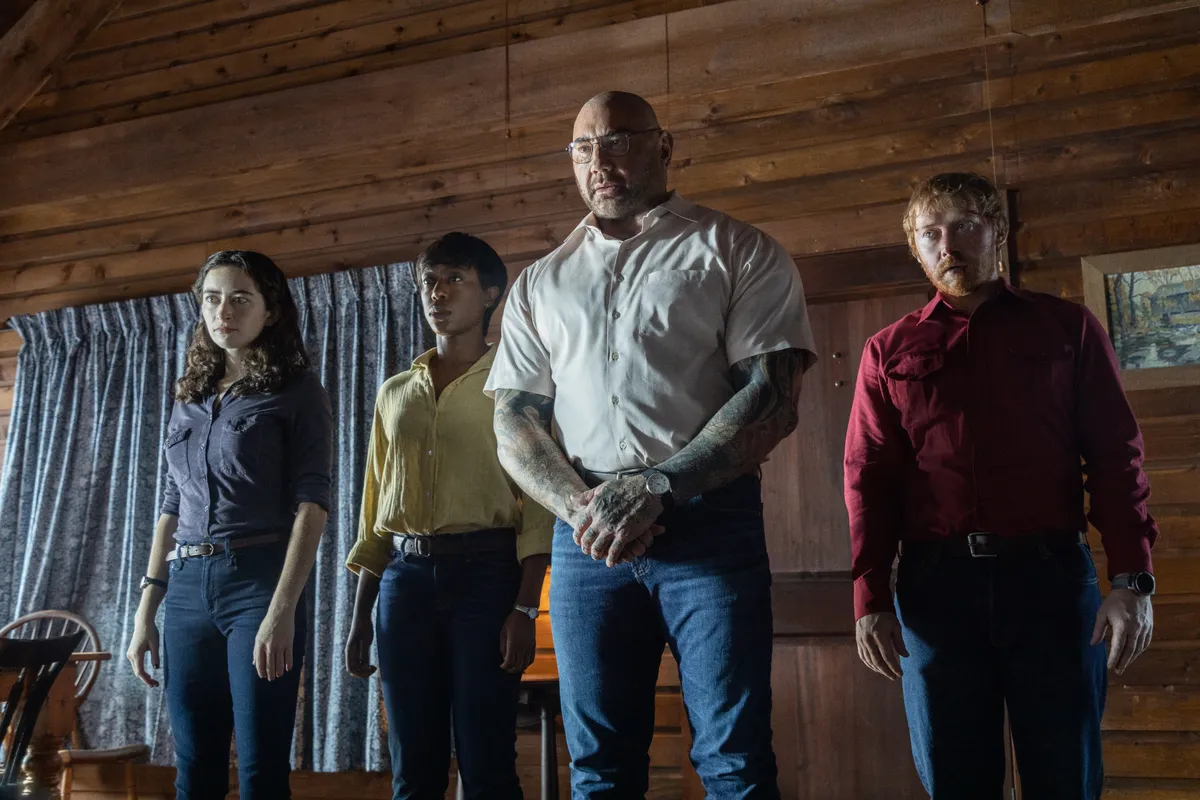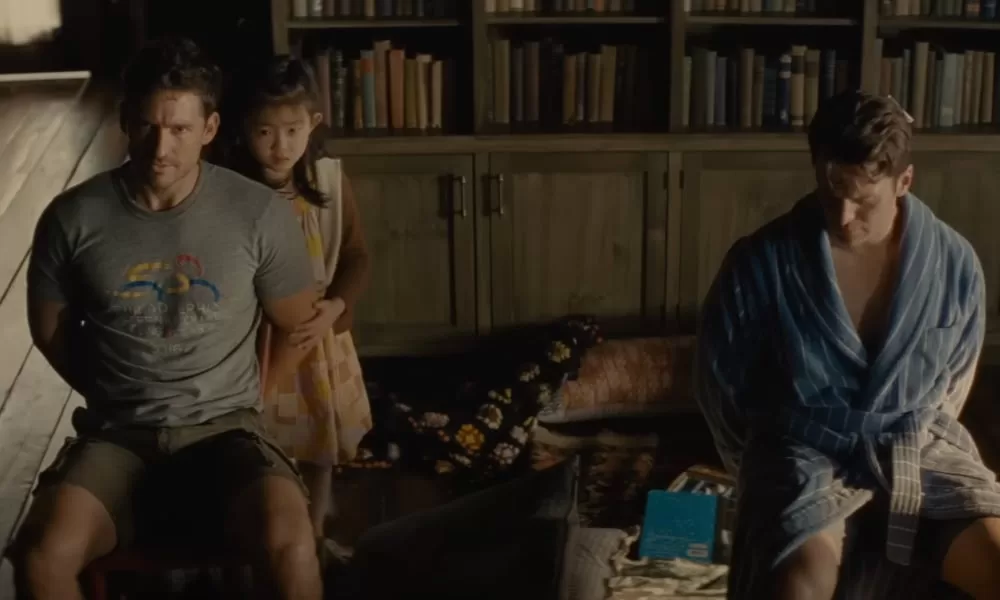I answered the Knock at the Cabin, and in walked… M. Night Shyamalan’s best movie next to The Sixth Sense?? I know that doesn’t sound right, and I don’t believe it myself, but since I haven’t seen some of his older films in a while, I’ve got to go with my gut because this movie fucked me up. It’s an incredible showcase for Shyamalan’s skills as a director, and unlike some of his previous films I may be more fond of (Unbreakable, Signs, The Village, The Visit, Split), it’s a simple, tight, focused story that has less room to disappoint narratively when it’s engaging you so viscerally.

Based on Paul Tremblay’s The Cabin at the End of the World—an objectively better title, why did they change it—the film, like the book, wastes little time establishing the premise and then simmering in tension until the end. Eric (Jonathan Groff) and Andrew (Ben Aldridge) and their adopted daughter, Wen (Kristen Cui), are enjoying their vacation when Leonard (Dave Bautista), Sabrina (Nikki Amuka-Bird), Adrian (Abby Quinn), and Redmond (Rupert Grint) titularly knock at the cabin and ask them to make a terrible choice: they must willingly sacrifice one of the three of them, or all of humanity will perish. It is an utterly absurd notion that the film treats with the utmost seriousness, and that is so up my alley it has its own mailbox. Apart from a few flashbacks that serve to flesh out this small family, pretty much this entire 100-minute movie takes place in or around the cabin, so that means for approximately 85 minutes of this movie, I wanted to claw my own face off out of sheer terror. This was practically Skinamarink levels of being trapped in a nightmare, and like Skinamarink, it’s a film that understands how to use the visual medium to unsettle the audience. (Also like Skinamarink, some people just found it boring, and I was sorry they couldn’t get into it like I did.)
Frequent Robert Eggers collaborator Jarin Blaschke and Greener Grass cinematographer Lowell A. Meyer shot the film with nineties cameras, as Shyamalan wanted to give it an “old-school thriller” look, and so the film occasionally goes out of focus in certain areas, blurring the edges around characters or objects, which lends the film an eerie quality appropriate for a cabin at the end of the world. It feels otherworldly in its isolation. Shyamalan also favors extreme close-ups that can be jarring on a huge silver screen, but that uncomfortable closeness simultaneously allows for greater connection to the characters and enhances our uneasiness at being in this situation with them. The film introduces this visual language right up top in the opening conversation between Leonard and Wen, which could be shown in a film class for a simple demonstration of how to use the camera to say something the dialogue does not. Because on the page, it’s just a friendly conversation between a child and a stranger, but editor Noemi Katharina Preiswerk never leaves their faces, choosing precise moments to switch to shots that subtly move closer and closer as the danger creeps in, and when it switches to canted angles, the universal sign for disorientation, you know it’s bad news. This whole film is just exquisitely shot, and Shyamalan displays so much restraint in depicting devastating emotions and brutal violence, it’s beautiful.

While I could go on and on about the visuals, I would be remiss not to mention composer Herdís Stefánsdóttir—are Icelandic composers inherently fantastic??—who delivers an excellent score that adds texture without calling too much attention to itself. That’s the thing about this movie: it’s incredibly well crafted, with every aspect of film used toward a singular purpose.
Shyamalan completely sells the apocalyptic dread while also making us feel the conflict that every character is having, both the Invaders and the Invadees. Because while obviously we sympathize with the family, it’s clear the people asking them to make the choice struggle with their role in this, each one of them bringing a distinct energy. Bautista, the gentle giant. Amuka-Bird, the helping healer. Quinn, the mordant Millennial. Grint, the angry asshole. They’re just four ordinary people trying to save the world. Or they’re four ordinary people under a shared delusion that the world is ending. The trick of the film is that either option is terrifying for the family, and while Eric and Andrew initially, vehemently choose the latter option, Eric slowly drifts toward the former, which allows for some conflict between the characters as well as giving the audience reason to doubt themselves. This movie kept putting me face-to-face with the idea of the literal end of the world and how hopeless everything would seem in that moment while also floating the unfathomable idea of trusting some strangers that killing someone you love more than anything in the world would stop it.

Shyamalan rewrote Steve Desmond and Michael Sherman’s Black List-featured adaptation of the novel, and who knows what to attribute to whom, but the combined efforts do give the film a more chilling inevitability in its structure compared to the book, which I found underwhelming as an audiobook listened to over two weeks. I found the story much more effective in this compressed experience, not to mention when given the Shyamalan treatment in its ending. While Shyamalan does succeed in bringing out the ambiguity of the book for much of the film’s runtime, anyone who’s seen a Shyamalan film knows that dude loves explaining his movies, so if you’re a person who hates having things explained, too bad, I love having things explained to me because I am a plebeian dunderhead. The way Shyamalan reframes the story to comment on humanity really worked for me, holding both the beauty and ugliness of the species at once, and to do it in the context of this unconventional family of a gay white couple with an Asian daughter made it all the more resonant.

While I completely understand some disappointment that the film perhaps did not dig as deeply into its themes and premise as it could have, I found that even though it explained more than the book, what it left unexplained made it all the scarier. I walked out of the theater shaken by the experience.
4.5 out of 5 stars
